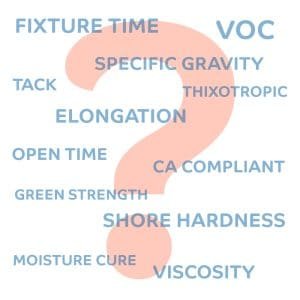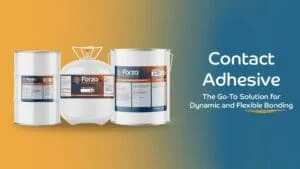Common Adhesive Terms, Explained
There are so many adhesive terms floating around out there – you’ve probably heard them all but don’t know what half of them mean. So…we present to you, our all-inclusive list of adhesive terms and definitions! If there’s anything you think is missing, let us know!
CA-Compliant: The product has low or 0-VOCs, and does not exceed California’s VOC limits
Cure time: The length of time it takes and adhesive to cure, or dry
Double-sided: A tape or a surface with 2 coatings of adhesive (learn more about 2-part vs single-part)
Elongation: The distance an adhesive/tape will stretch before it breaks
Fixture time: The time required for an adhesive to develop handling strength
Flammable: Something that can be set fire to, or that would have flammable vapors (flammable adhesives are no longer flammable once dry)
Flash time: The length of time needed before another coat of adhesive can be applied or the surface can be bonded
Gel time: The length of time it takes until an adhesive is no longer workable
Green strength: The early development of bond strength after an adhesive or tape has been applied, before it reaches full strength
HAPs: Hazardous Air Pollutants
LEED: Leadership in Energy and Environmental Design, an internationally recognized green building certification system
Moisture-cure: When something requires the presence of moisture in the atmosphere to cure
Non-flammable: The opposite of “flammable” – something that cannot be set fire to, or has no flammable vapor (learn more about non-flammable adhesives)
Open time: The length of time during which an adhesive is considered workable – it is during this time that the surfaces can be bonded
Peel strength: The average force required to part two bonded materials, by pulling them back in a peeling motion (learn about adhesive strength tests)
Plasticizers: Materials that are added to a raw polymer to increase the flexibility and decrease the brittleness of the product (learn more about plasticizers)
PSA: Pressure Sensitive Adhesive (learn more about PSA’s)
PSI: Pounds per Square Inch
SDS: Safety Data Sheet (Learn how to read your SDS)
Shear strength: The load that a material is able to withstand in a direction parallel to the face of the material (learn about adhesive strength tests)
Shelf life: The length of time for which an adhesive/tape remains usable
Shore hardness: The amount of hardness, or resistance to indentation, that a material has
Single-sided: A tape or a surface with 1 coating of adhesive
Skin time: The length of time after an adhesive has been applied, to when the outermost layer has cured enough to form a “skin”
Solids content: The amount of base product (proportion of non-volatile material) left in the adhesive once the solvent has vaporized (learn more about solids content)
Specific gravity: The ratio of the density of an adhesive to the density of water
Surface prep: The process of getting materials ready to bond (learn more about the importance of surface prep)
Tack: How quickly a bond is produced after applying an adhesive
Tensile strength: The resistance of a material to breaking under tension, while an axial stretching load is applied (learn about adhesive strength tests)
Thixotropic: Having a viscosity that decreases, or becomes more liquid, when a stress such as shaking or stirring is applied
UV cure: When something requires UV (ultraviolet) light to cure
Viscosity: The measure of an adhesives’ ability to resist flow, often referred to as the “thickness” of an adhesive
VOC: The definitions of VOC is Volatile Organic Compound
Work time: The amount of time an adhesive is considered “workable”, which is the time between when an adhesive has set and when it will no longer bond
And there you have it, your all-inclusive list of adhesive terms and definitions! Are there any words we missed? Let us know, and we’ll update this list!




